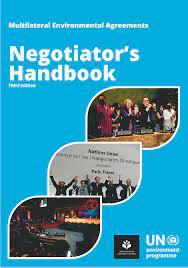
https://www.unep.org/resources/toolkits-manuals-and-guides/multilateral-...
https://sdg.iisd.org/news/unep-handbook-offers-guidance-on-process-and-s...
Multilateral Environmental Agreement (MEA) negotiations are among the most dynamic negotiations in international law. The process, structure and substance of negotiations has been evolving over time requiring negotiators to be well guided on procedural as well as substantive aspects of negotiations. . This is the third edition of the MEA Negotiators Handbook is a joint publication by the Center for Climate Change, Energy and Environmental Law (CCEEL) at the UEF Law School and UNEP. Multilateral Environmental Agreement (MEA) negotiations are among the most dynamic negotiations in international law.
The Second Edition of MEA Negotiators Handbook was published in 2007. This is the reason for revising and updating this negotiators’ handbook from time to time, so that negotiators can be well guided on the process and the structure of negotiations. Since 2004, UNEP and the University of Eastern Finland (UEF) have coorganized an Annual MEA training Course on negotiations and diplomacy focusing on MEAs to equip negotiators on their role as well as on the process and structure of MEA negotiations. The Ministry for Foreign Affairs (MFA) has funded the course along with UNEP and the Ministry of the Environment of Finland.
Noting that MEA negotiations “are among the most dynamic negotiations in international law,” the handbook guides negotiators on the process and the structure of talks.
The publication titled, ‘Multilateral Environmental Agreements Negotiator’s Handbook,’ is in its third edition, updating a 2007 handbook. It condenses 372 pages of advice into 12 essentials that emphasize that “representing your country in a multilateral negotiation is a serious undertaking and a major responsibility” and that preparation is key.
The guide underscores the need to “support the process and participate constructively even in difficult situations” as “[u]nwarranted obstructionism can undermine the whole system.” It recommends that negotiators try to identify win-win situations and look for opportunities to support countries with different interests.
Highlighting the importance of good relationships, trust, humor, and diplomacy, the handbook urges focus on substantive objectives and interests rather than positions. It offers concrete recommendations on bracketing text, optimizing discussions, exercising responsible judgment, structuring interventions, and preparing for practical necessities.
The handbook provides an overview of the history and context of MEAs, their forms, nature, principles, and elements, as well as the “machinery” behind MEA negotiations. Among the many aspects of MEA negotiating process, the handbook elaborates on the rules of procedure, financial rules, institutional and negotiation structures, and country groupings.
The guide describes a typical day in UN negotiations, products of MEA negotiation phases, and cross-cutting issues, including governance principles and objectives, international cooperation issues, and trends in MEA negotiations. It also provides recommendations on participating in virtual intergovernmental meetings.
The publication features several annexes that include overviews of selected MEAs, case studies, and reference texts and electronic resources.
Published on 12 March 2024, the handbook supports the annual MEA training course on negotiations and diplomacy UNEP and the UEF have co-organized since 2004. The course is funded by the Government of Finland and UNEP. [Publication: Multilateral Environmental Agreements Negotiator’s Handbook] [Publication Landing Page]









